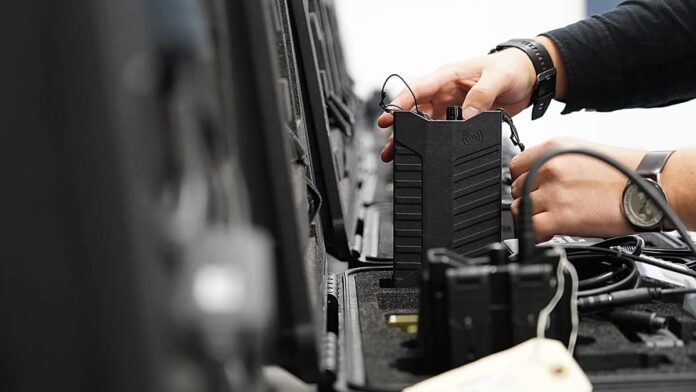In a warehouse hundreds of kilometres from Ukraine, workers in northern Denmark painstakingly piece together anti-drone devices.
Some of these are to be exported to Kyiv in the hopes of jamming Russian technology on the battlefield, while others will be shipped across Europe in efforts to combat a series of drone intrusions into NATO’s airspace that have set the continent on edge.
Two Danish companies whose business was predominantly defence-related now say they have seen a surge in new clients seeking to use their technology to protect sites such as airports, military installations and critical infrastructure, all of which have been targeted by drone flyovers in recent weeks.
Weibel Scientific’s radar UAV detection technology was deployed ahead of a key EU summit earlier this year at Copenhagen Airport, where unidentified drone sightings closed the airspace for hours in September.
Counter-drone firm MyDefence builds handheld, wearable radio-frequency devices in its warehouse in northern Denmark that sever the connection between a drone and its pilot, neutralising the threat.
So-called “jamming” is restricted and heavily regulated in the European Union, but widespread on the battlefields of Ukraine and has become so extensive there that Russia and Ukraine have started deploying drones tethered by thin fibre-optic cables that do not rely on radio frequency signals.
Russia is also firing attack drones with extra antennas to stymie Ukraine’s jamming efforts.
Spike in drone incursions
Drone warfare exploded following Russia’s full-scale invasion of Ukraine in 2022.
Russia has bombarded Ukraine with drone and missile attacks, striking railways, power facilities and cities across the country.
In response, Ukraine has launched its own strikes on military and energy targets deep inside Russia using domestically produced drones.
But Europe as a whole is now on high alert after drone flyovers into NATO airspace reached an unprecedented scale in September, prompting European leaders to agree to develop a “drone wall” along their borders to better detect, track and intercept drones violating Europe’s airspace.
In November, NATO military officials said a new US anti-drone system had been deployed to the alliance’s eastern flank.
And following a violation of Polish airspace, NATO Secretary General Mark Rutte announced the formation of the Eastern Sentry programme, which aims to deter further Russian incursions.
Some European officials described the incidents as Moscow testing NATO’s response, which raised questions about how prepared the alliance is against potential threats from Russia.
The Kremlin has dismissed allegations that Russia is behind some of the unidentified drone flights in Europe as “unfounded.”
Key challenges include detecting drones, which are sometimes mistaken for birds or planes on radar systems, and taking them down cheaply.
Andreas Graae, assistant professor at the Royal Danish Defence College, said there is a “huge drive” to rapidly deploy counter-drone systems in Europe amid Russian aggression.
“All countries in Europe are struggling to find the right solutions to be prepared for these new drone challenges,” he said. “We don’t have all the things that are needed to actually be good enough to detect drones and have early warning systems.”
‘Machines before people’
Founded in 2013, MyDefence makes devices that can be used to protect airports, government buildings and other critical infrastructure, but chief executive Dan Hermansen called the Russia-Ukraine war a “turning point” for his company.
More than 2,000 units of its wearable “Wingman” detector have been delivered to Ukraine since Russia invaded nearly four years ago.
“For the past couple of years, we’ve heard in Ukraine that they want to put machines before people” to save lives, Hermansen said.
MyDefence last year doubled its earnings to roughly $18.7 million (€16.1 million) compared to 2023.
Then came the drone flyovers earlier this year. Besides Copenhagen Airport, drones flew over four smaller Danish airports, including two that serve as military bases.
There were also similar incidents in Romania, Lithuania and Norway.
Hermansen said these episodes were an “eye-opener” for many European countries and prompted a surge of interest in their technology.
MyDefence went from having the vast majority of its business defence-related to receiving inquiries from officials representing police forces and critical infrastructure.
“Seeing suddenly that drone warfare is not just something that happens in Ukraine or on the eastern flank, but basically is something that we need to take care of in a hybrid warfare threat scenario,” he added.
Radar technology used against drones
On NATO’s eastern flank, Denmark, Poland and Romania are deploying a new weapons system to defend against drones.
The US-made Merops system, which is small enough to fit in the back of a pickup truck, can identify drones and close in on them using artificial intelligence to navigate when satellite and electronic communications are jammed.
The aim is to make the border with Russia so well-armed that Moscow’s forces will be deterred from ever contemplating crossing the line from Norway in the north to Turkey in the south, NATO military officials said.
North of Copenhagen, Weibel Scientific has been making Doppler radar technology since the 1970s.
Typically used in tracking radar systems for the aerospace industry, it’s now being applied to drone detection like at Copenhagen Airport.
The technology can determine the velocity of an object, such as a drone, based on the change in the wavelength of a signal reflected back.
Then it’s possible to predict the direction the object is moving, Weibel Scientific chief executive Peter Røpke said.
“The Ukraine war, and especially how it has evolved over the last couple of years with drone technology, means this type of product is in high demand,” Røpke said.
Earlier this year, Weibel secured a €65 million deal, which the firm called its “largest order ever”.
The drone flyovers boosted the demand even higher as discussion around the proposed “drone wall” continued. Røpke said his technology could become a “key component” of any future drone shield.
